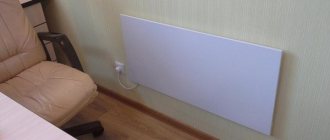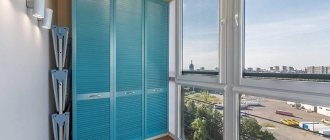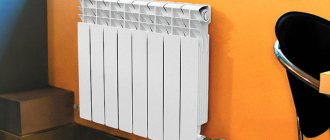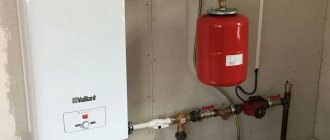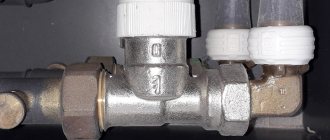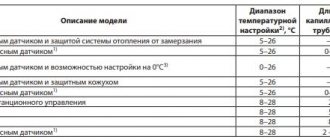In many apartments, a balcony or loggia serves as a dumping ground for all kinds of garbage, jars of pickles, and sports equipment. This happens because it is simply impossible to stay there in winter. If you save on insulating your balcony, then in the cold season the temperature on it can drop below 0 degrees.
Making a loggia into a full-fledged living space does not cost a lot of money or effort. To do this, it is not necessary to carry out a full renovation. But if possible, you need to think about heating a balcony or loggia already at the construction stage.
Insulation of the loggia during the construction phase
The tips in this section are suitable for “bare” balconies and loggias. The main difference between these two rooms is that the balcony protrudes from the facade of the house, and the loggia is separated from the main room by a wall. Read more in the article “What is the difference between a loggia and a balcony?”
The first thing you should decide is whether you are ready to start insulating the outside. This may require special equipment if you live above the 1st floor. Double-sided insulation is necessary for large rooms.
Seal all cracks with sealant (small) or foam (large). Heat escapes through them the fastest. Level all walls with putty and cement mortar. This increases the efficiency of thermal insulation.
Pay special attention to moisture insulation. Dampness attracts cold. Treat the internal and external walls with a moisture-repellent solution before installing heat-insulating panels.
Reviews
Vladimir, 42 years old:
“I took Kaleo UTH-150 to install heated floors in the bathroom. The device was originally planned to be installed in a power outlet box. I figured it out quickly with clear instructions in Russian, and connecting did not cause any problems. The device operates in 2 modes: programmable and emergency. The required functions are set using the operating buttons on the front of the panel. The current temperature and settings are displayed on a seven-segment LED display. The regulator looks stylish, is easy to use, durable and functional. In addition, the kit includes replaceable covers that allow you to adapt the device to any interior.”
Ivan, 36 years old:
“I am the happy owner of a heated floor managed by Devi. The thermostat is equipped with a touch display. It meets the needs of even the most demanding owner: reliable, 5-year warranty, can be installed in frames of sockets with switches. With proper installation and correctly set settings, the device pays for itself within a year.”
Heating a bathroom, loggia or balcony with an electric heated floor is a simpler and more affordable way compared to other heating systems. The efficiency of the entire system and energy efficiency depend on the choice of thermostat.
Insulating materials
The following types of insulation are available on the market:
- expanded clay;
- mineral wool;
- expanded polystyrene;
- polyurethane foam;
- penofol.
Choosing the optimal material is easier than it seems.
Expanded clay
This is the cheapest material. Does not hold its shape, readily absorbs moisture. Durable, resistant to fire, mold, mildew. It is used to insulate the floor on the balcony when they want to save money.
Insulating the floor on the loggia with expanded clay
Mineral wool
Medium price material. Its slabs are very wide, so they are not suitable for small spaces. The ingress of moisture impairs the insulating properties. Mineral wool is environmentally friendly, fire-resistant, and creates additional sound insulation.
Balcony insulation with mineral wool
Expanded polystyrene
Expensive insulation, devoid of any shortcomings. The plates are easily attached to any surface using self-tapping screws. The best option for any room.
Polyurethane foam
Liquid insulation. Easily fills any cracks and cavities. Special equipment is required for installation. Dismantling presents some difficulties.
Penofol
Auxiliary thin heat and water insulator. It is used together with expanded polystyrene and mineral wool to create an additional air layer.
After you have chosen a thermal insulator, proceed with installation. First, all walls, floor, and ceiling must be covered with a layer of waterproofing made of polyethylene or foam foam, and the joints between the sheets must be glued with tape.
Balcony insulation with penofol
Then a metal or wooden frame is built (for more details, see the article “balcony sheathing”), into which the insulation will then be laid. The distance between it and the surfaces must be sealed with polyurethane foam. Next, the insulating boards are tightly laid. There should be no gap between them and the frame, otherwise all the work will go down the drain.
A rough covering of chipboard and plywood is built on top of this structure. You can install a heated floor on the loggia. Then finishing work is carried out.
Quartz heaters
There are monolithic and infrared. The difference lies in their structure:
- for monolithic ones, the heating panel is made from quartz;
- In infrared heaters, quartz is the material for heating pipes.
Heating is carried out by a nichrome thread built into the panels or quartz tubes. Heated quartz emits infrared heat, heating nearby objects.
Quartz heater
Advantages of monolithic quartz heaters:
- affordable price;
- design in which there is nothing superfluous;
- no noise during operation;
- health safety;
- heating the room does not take much time.
Disadvantages of monolithic quartz heaters:
- ceramics weigh a lot;
- it is necessary to additionally purchase a thermostat;
- a protective screen is required to avoid getting burned on the panel;
- ceramics is a fragile material.
Quartz infrared heater
Advantages of quartz infrared heaters:
- Safe - all heating elements are located behind a durable grille, and the device also turns off automatically when tipped over;
- Silent – can be installed directly in recreation areas;
- Compact and mobile - does not require installation, and can be removed if necessary;
- Durable – if used carefully, the heater will serve you for a very long time;
- Economical - there is a timer and temperature regulator. Disadvantages of quartz infrared heaters:
- Uneven temperature distribution - such a unit does not heat the air, but only the objects it is directed at; accordingly, if the heater is directed at you at the level of your feet, then at the level of your head you will be cold;
- Some elements get very hot, and if you are careless, you can get burned;
- The fragility of the vacuum quartz flask - if damaged, it is almost impossible to repair it;
- The room cools down quickly.
Do-it-yourself insulation of a balcony
If you don’t have time to do a full-fledged balcony repair with your own hands, use some folk methods of insulating a loggia. The temperature may rise by several degrees. Remember that this is a temporary measure. Such “tricks” cannot replace full thermal insulation.
Walk around the loggia with a candle or lighter. This will help determine from which joints and cracks the air is blowing. Seal them with putty. Draft is the worst enemy of heat.
Construct insulating panels from scrap pieces of foam. This material conducts heat poorly.
Such improvised insulation can be done in a few hours, but even this little thing reduces the chance of catching a cold from the cold coming from the loggia.
Central heating radiators
Previously, it was possible to bring the central heating radiator onto the balcony without any problems. It was not forbidden to do the installation yourself. But now such actions are an administrative article.
The government has decided to limit the ability of residents of apartment buildings to change the layout of heating systems. This was done for security reasons. The battery on the loggia may freeze and burst.
Having an experienced lawyer and observing all the regulations, such redevelopment can be legalized through the court. This takes time and money, but as a result you get full heating of the loggia.
Water floor heating
The water heating system is a polymer tube that is installed under the screed. It can be connected to both a gas boiler and a central heating system.
Don't forget to check the water heating on the balcony before screeding it. This can save you from paying compensation to your flooded neighbors.
Advantages - low price.
Flaws:
- damage to the tube can lead to a flood;
- fragility;
- Difficult to connect to central heating system.
Conclusion: a budget balcony heating system, which makes sense to install if you have an economical gas boiler.
Fan heaters
Fan heaters are also quite widespread as balcony heaters. Their only advantage is their relatively low price.
Otherwise, they are energy-intensive, quite noisy, and are not equipped with an automation system that regulates the temperature and operating time of the device.
Therefore, they will require the installation of either a separate thermal relay, which will turn off the fan heater, or manual control, which is inconvenient.
In addition, fan heaters that use a nichrome spiral as a heating element fail very quickly.
Electric floor heating
Electric balcony heating is more expensive and more reliable than water heating. Installation is almost no different from water systems. The only difference is that the electric floor must be connected to the power supply.
Advantages:
- durability;
- simple installation;
- precise temperature control.
Flaws:
- high price;
- needs stable mains voltage;
Conclusion: a durable system for apartments and small suburban premises.
There are two types of electric heated floors on the balcony:
- cable;
- infrared.
The latter type is more modern, but it is not without its drawbacks.
Cable electric heating
The heating element of such a system is a single- or two-core wire that has two layers of insulation. Cable heating on the balcony is not very economical.
Infrared electric heating
Thin thermal films of an infrared heating system consist of strips of graphite, isolated from each other and from the environment. This heating is 20% more economical than cable analogues, it is completely safe, but its service life is no more than 15 years.
Infrared ceiling or wall heaters
This type of heater is placed on the walls and ceiling. Their operating principle is based on infrared waves. They heat nearby objects, which, in turn, heat the air.
Infrared wall heater
Advantages of using infrared heaters on the balcony:
- — uniform heating of the room;
- - efficiency;
- - high efficiency.
Infrared ceiling heater
Features of using infrared ceiling and wall heaters for balconies:
- strong dependence of surface heating on the distance to the heater;
- not suitable for balconies with a small area, rather suitable for terraces;
- it is better to choose extended low-power options;
- Models with power control have an advantage (for example, with a 0.5 and 1 kW switch);
- the heater housing often becomes very hot;
- sockets or connected wire to the installation site are required;
- it is often non-rotating, i.e. it will not be possible to direct it to another part of the balcony;
- heating feels like solar heat;
- there is no need to heat the entire balcony; you can almost instantly begin to warm up any area, for example, a workplace.
Heating with electric appliances
If you were able to insulate your balcony, but you don’t have enough time or money to install a heating system, use heaters. Understanding all the variety of these devices can be difficult. Let's look at each of them in more detail.
Fan heater
A fan heater is an inexpensive option for auxiliary or spot heating on a loggia.
It consists of:
- housings;
- heating element;
- heat dissipation systems.
The body can be made of plastic or metal. After prolonged use, the plastic may burn and melt in some places. This does not affect the operation of the device, but still you should not spare money on purchasing a high-quality heater.
The key part of an electric fan heater is the heating element.
Main types:
- Spiral made of nichrome wire. It is used in the cheapest devices. It has a high temperature and very low heat transfer.
- Tubular heating element. A metal tube filled with a heat-conducting substance. It has average heating and heat transfer rates.
- Ceramic. Semiconductor heating element coated with glass ceramics. Has the highest heat transfer parameters.
For a small room, floor-mounted stationary or mobile fan heaters in a metal casing are suitable.
Convector for the balcony
A convector is a thermal panel, an automatic heater that gradually changes the temperature in the room. Cold air enters the housing, heats up, and then is blown back out. The heating element does not heat up above 100 degrees, which reduces the likelihood of fire in surrounding objects to a minimum.
The thermal panel may have the following heaters:
- Electric. Nichrome spiral, tubular electric heater, infrared element. Expensive models are characterized by increased efficiency and reduced energy consumption.
- Gas. Economical, but requires connection to a gas cylinder and a central gas pipeline.
A convection heater should be used to maintain a constant temperature on the balcony.
Oil radiator
An oil heater resembles a regular water battery, but works much more efficiently.
It consists of:
- metal radiator;
- mineral oil with high thermal conductivity;
- tubular electric heater;
- temperature and power control systems.
Radiators come in two types:
- panel;
- sectional.
Always choose a sectional oil cooler. This design has an increased area of contact with the surrounding air. There are mobile and stationary models. Choose equipment depending on the size of the balcony.
What to consider when choosing a device
Choosing a heater for a balcony or loggia has some nuances. They relate to both the device itself and the features of the room.
If your balcony is used as:
- pantry for vegetables, canned food, preparations - you need a temperature of about 3-5 ° C , that is, simple insulation of the balcony without installing a heating system is enough;
- a work office, a sports corner, a place for hobbies or growing a mini-garden - periodic heating of the room or the temperature required for specific plants is suitable;
- permanent living space or space attached to a room - the temperature should be constant, within 20-25°C .
In cases where the balcony is glazed, but unnecessary or seasonal items are simply stored on it, laundry is dried, etc., it makes no sense to install special heaters.
Another important aspect is the area of the balcony. If it is small and not filled with furniture, one heating device on the ceiling or a regular fan heater will be enough. If you have a spacious loggia at your disposal, you can think about organizing a heated floor system.
The operating features of a particular heater are also important to consider. As mentioned above, there is no need to install heating radiators on a balcony that you rarely use.
